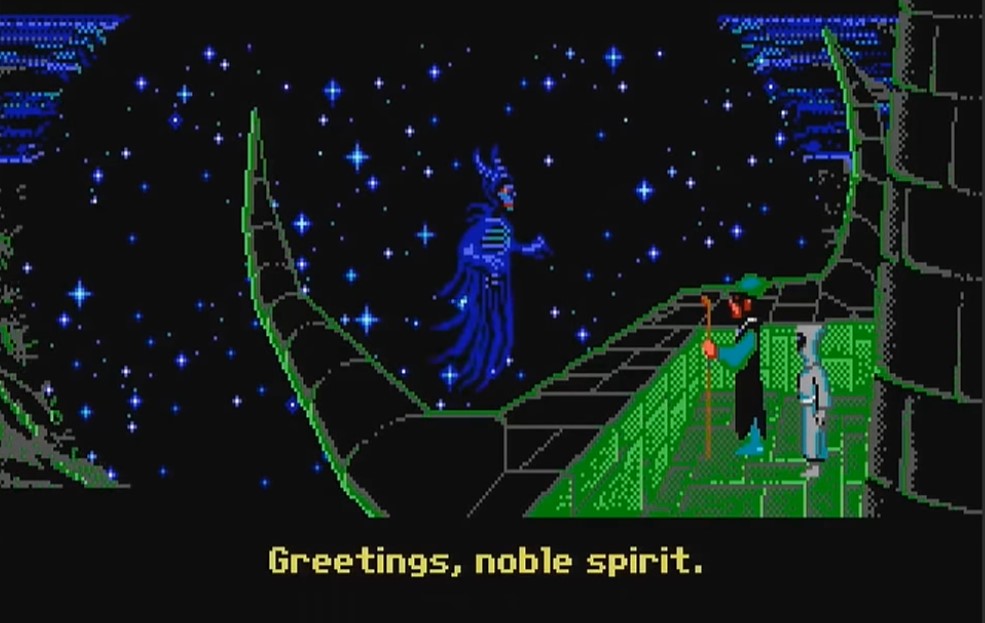Hello, my name is Damiano. Don’t ask me about Loom cause I have never played it. During that wonderful period that was the 90s, it was the one classic Lucasarts adventure games that no one talked about nor had a copy laying around to play. Monkey Island was everywhere and so were Day of the Tentacle, Full Throttle and Sam & Max. All of these titles I found in the shops, where I originally bought my copies. Loom? What?
Maybe it had something to do with its intricate red glasses copy protection and audio drama or the fact that it never received an official Italian translation even years after its release. Whatever the reason, I found out about Loom being one of the classic Lucasarts adventures only many years later.

Amending past mistakes
As 2004 rolled on, I was indeed one of those Lucasarts fanatics, but I expected my adventure games to be filled with zany characters and illogical situations, a game with a serious fantasy vibe didn’t sound appealing to me. Once I saw the screenshots, the “distaff” interface ended up putting me off for good. You might be wondering why I am telling you all this.
Basically I’m still trying to explain to myself how I could let Loom escape my grasp all this time. 2020 came around and, finally, I made up my mind: it was time to correct that glaring omission. I finished the game and now I’m giving it its due with this article, trying to find out why it was so hard to find and not very popular, especially compared to its siblings.

Initial game design and story
The game was designed by Brian Moriarty in 1988 and released two years later. The “professor”, coming strong from designing several classic textual Infocom adventures, had the clout and the courage to pursue a unique vision at Lucasfilms, with the help of talented people like Mark Ferrari and Steve Purcell.
Indeed, Loom is the “odd one out” of classic graphical adventures. It uses the SCUMM interface that made classics of titles such as Maniac Mansion and Zak McKracken, while doing away with what made it instantly recognizable. Loom doesn’t have the classic verb interface neither does it have dozens of items to be picked up; actually, there’s no inventory at all. Moriarty wanted the player to be fully immersed in the atmosphere and story, as to open up the game to a larger public than other SCUMM titles. Thus, he created a story based on Tchaikovsky’s Swan Lake (as is the wonderful soundtrack), where as the “prophecy child”, the player will be tasked with saving what’s left of the world from a great evil.
Since Moriarty was in love with the idea of a gesture-controlled interface, Loom uses a keyboard friendly “distaff” musical system. The player will learn spells (drafts) to interact with items and people as they progress in game and “level up” by earning new notes that can be played. Each drafts has four notes that it is necessary to remember and play on the staff, since the game doesn’t keep track of any the spells encountered.
At the beginning it is possible to backtrack and listen to the drafts again, but pretty soon, that opportunity will be taken away. Most spells are randomly calculated each time a new game is started, should the player wish to save, restart and then go back, that would end up being a dead end. The manual actively encourages the player to write everything down, as was customary back in the day and, sure enough, one would be well advised to do the same even now. To tie in the story, the game box included a cassette with a 30 minute audio drama.

These two elements are key to understanding why Loom’s design is different from any other ordinary adventure. No other Lucas games included so much lore the player needed to be introduced to, the internarrative typical of Infocom games seemed to be still an inspiration for Moriarty.
Loom forces the player to slow down, note down the spells encountered and even listen to the audio drama before starting to play. It wants the player to take their time in order to fully appreciate the world they’re entering, to feel like they are actually there playing notes along with the prophesied Bobbin Threadbare. Approaching it with the usual “moon logic” or brute force like any other adventures featuring riddles and puzzles, would only result in a pretty frustrating, along with disappointing, experience.
Designing it with an idea to make Loom more approachable, at the time, meant making it different from most other adventure games, as it is customary in the world of videogame, variety and originality are rarely rewarded by the large gaming public. Many would be pretty content in playing the same title over and over for the rest of their lives: another Monkey Island, another Doom, another Fortnite.

Don Bluth meets Jim Henson
Loom walks a similar thread (pun intended) to a Don Bluth cartoon trying for a foreboding atmosphere a là The Dark Crystal. It’s no coincidence that in the postmortem video at GDC – heavily recommended viewing – Moriarty namechecks the Jim Henson related game Labyrinth as the other “fantasy Lucasarts title”.
The story of Bobbin Threadbare feels appropriately dramatic and heavy, the world hangs in the balance and an evil force is killing people left and right. Still there are many light touches of humour, especially in the names of the characters the player meets that have a sort of unique “Sierra” feel. Even though it is indeed shorter and easier than most other adventures, Loom, even after all these years, still feels unique and not really like it was meant for a younger audience.
Writing a story between magical adventure and fleshed out world feels rightly of its time, but the weaving narrative and the direct approach to the player almost feels straight out of an indie game from 2015. Ironically enough, the way it was designed to be playable by beginners and experts alike, made it “the odd one out” that tends to be skipped on even today.
Another incredible feature is how Loom manages to expertly conceal many of its mysteries, so while playing it always feels like there’s much more beneath the surface of the story. Moriarty himself concludes that he didn’t realize how much the ending felt like a set up for a sequel that never materialized. I guess even the hints he threw at Doublefine and Wadjet Eye during his 2015 GDC speech didn’t really go anywhere.

Loom’s gifts for the future
It took me almost 20 years to finally get to Loom. In a way I’m glad, because I could savour it without feeling any kind of pressure or influence from other titles, even those of its time. Still, I can’t help but feel a slight tinge of sadness for waiting all this time. While doing research for the article, I ended up perusing several youtube vidoes where I read so many comments of people that learned English thanks to this game, like I did with many titles on the C64. One would sit at the screen, dictionary beside the keyboard and look up each word that sounded unknown.
Even though it’s not often mentioned among the classic titles from the 90s and sometimes not even from the memorable adventure games, it is clear to me now why this title is still so important to so many people. It feels… Different, in an honest and sincere way. A work of someone who cared very much about everything he was doing, no other proof needed than the emotion Moriarty throws in while speaking about this game even though so many years have passed. He almost breaks down when remembering the inspiration he was struck by.
I feel lucky to have witnessed, all these years later, at least a tiny part of that emotion.

Thank you for reading.
If you would like to support the project, you can do so by joining my Patreon or offering me a coffee.





You pinpointed a fact about Loom that is too often overlooked : it’s not exactly a LucasArts (or Lucasfilm Games, to be precise) game, it’s rather an Infocom game in LucasArts clothings. The fantasy universe is reminiscent of the Enchanter / Sorcerer / Spellbreaker trilogy, and the evolutive interface (ie getting new tunes/spells as you progress in the game) comes directly from Enchanter. It’s a rare case of two distinct designs and visions of two studios being merged in a single game. As a fan of rock, metal and electronic music, and anything bout influences and side-projects, I would have loved to see that more often in the video game world. Like someone from LucasArts and someone from Sierra making a game together, or collaborations between American, European and/or Japanese developers (well, that happened sometimes, but not enough !).
However, the Infocom influence has a price : the absence of dialogue interface, the linearity and the short lifetime of the game. In Infocom games, it was buried under the text interface and the time spent to find the good commands, but here it’s more obvious, and it disappointed some reviewers in 1990. And it’s interesting to see Loom as a precursor of shorter, more original Indie games.
Completely in agreement here. It definitely would have been interesting to see more “limits” being pushed, more software houses out of their comfort zones. And it makes sense that Loom is the one Lucasarts adventure that is often overlooked, because it never does feel like one, from the interface – as you said – to the fantasy plot which is also pretty much absent from all other 90s Lucas outings.